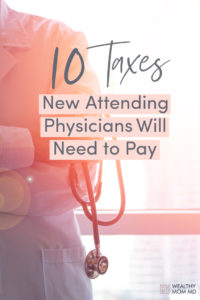You crushed college, medical school, and residency. You're finally looking at the light at the end of the tunnel. All of your hard work is paying off, and you cannot wait for your first attending physician paycheck. And … you may not be aware of the 10 new attending physician taxes you’re about to pay.
#1 Income Taxes
To help you have a better handle on the income taxes you will owe as a new attending physician, it is important to understand the difference between federal marginal and effective taxes. Your marginal tax bracket is the % tax you pay on the last dollar you earn. This is not the bracket you pay every dollar on. We have a graduated tax system here in the U.S. Essentially, as your income rises, so does your marginal tax rate. Based on your income, you are slotted into a tax bracket. When your income crosses a certain threshold, the amount of money over that level is then taxed at a higher rate. It is also worth noting that these brackets and rates change from time to time, so how they look in 2019 isn't how they will look forever.
Conversely, effective tax rates are calculated based on the total amount of federal income tax you actually pay. To get that calculation, you look not only at taxes taken from your income, but other factors like deductions that you may receive. Generally, this effective tax rate is lower than your marginal tax rate, but both numbers are worth knowing, especially as your income increases.
As a resident, you were probably either in the 22% or 24% marginal tax rate (federal income tax, 2018 tax tables). Your income will surely rise now, and you may find yourself in the highest marginal tax bracket, currently 37%. And depending which state you live in, you may also be slapped with an additional income tax of up to 10%. You will also pay city or local taxes in cities such as New York City and Philadelphia.
Finally, you’ll still continue to pay the 1.45% Medicare payroll tax, and a Social Security tax of 6.2% on the first $132,900 for 2019 taxes. The government seems to periodically increase this.
#2 Medicare Taxes
The additional 0.9 percent Medicare tax on wages above $200,000 for individuals ($250,000 married filing jointly), which went into effect in 2013, remains in effect for 2018. Also, the Medicare tax of 3.8 percent on investment (unearned) income for single taxpayers with modified adjusted gross income (AGI) more than $200,000 ($250,000 joint filers) still exists. As your income and investments grow, these taxes are worth remembering.
#3 Board Certification
Most of us will become board certified by our specialty to show patients that we have achieved the highest level of medical training.
The initial fees are not only steep, but then you need to arrange getting there. I paid $2,500 just to sit for my dermatology boards in Tampa, Florida. Adding in the cost of flights, hotel nights, and food increases that amount considerably. Many people will also pay for courses to prepare for this as well.
Also, this is not a one-time thing. I will need to re-certify in <10 years, which brings me to the next tax.
#4 Maintenance of Certification (MOC)
Maintenance of certification (MOC) is a relatively new thing. In fact, some physicians found themselves caught off guard by the changes in 2014. I initially thought I would just have to sit for the boards and do the annual required CME requirements for my board and the state I’m licensed in. Now, with all the extra demands placed on physicians to maintain safe patient practices, MOC was born.
What is MOC? MOC is basically extra requirements aside from re-certifying exams and annual CME requirements to maintain board certification, and you get to do this for another annual fee. MOC proponents maintain that helps physicians be better physicians. Interestingly, if you were board certified before a certain date, MOC does not apply.
#5 Medical License and DEA
Medical licenses are state specific. If you move or decide to practice in a different state, you need to apply and pay for a new state medical license. This makes sense for, say, lawyers since state laws differ. But in my opinion, this does not make any sense for physicians, since medicine does not change across state lines.
Every state pretty much asks for the same information: proof that you finished all the requirements of medical school and residency, passed the United States Medical Licensing exams, and for board certification, if applicable. Of course, there's also a hefty fee that ranges from $100 to much higher.
Each state has different requirements to maintain licensure, including things like the number of CME credits you need per year. Now, many states will also require specific topics, such as pain management (even if you never prescribe pain medications), infection control, and child safety.
It’s hard to know if you’re going to need licenses in multiple states over your entire career. If you knew you were going to practice in multiple states over your career, then you will want to consider a service such as the Federation Credentials Verification Service or FCVS. This is an agency that takes all of the documents that are required into a safe repository. Of course, they require a fee for this as well. Additionally, there are fees for sending them out to the different state licensure agencies. However, this greatly simplifies the process for you when you need to apply for multiple states instead of reinventing the wheel each time. Hopefully, a national license will emerge as telemedicine becomes more commonplace.
#6 Malpractice Insurance, etc.
You’ve always had malpractice during your medical training, whether you paid for it directly or not. Most attending physicians will have this paid for by their employer. But many attending physicians choose to work as independent contractors, in which case you’ll need to purchase your own.
The annual premium for this depends on many factors, including your specialty. It can range from a few thousand dollars per year upwards to over $200,000! It’s also important to know the difference between occurrence-based and claims-based malpractice. If you have the latter, then you will need to purchase tail insurance (or have your next employer pick up the tab). And most importantly, never let your malpractice insurance expire.
Don't forget about the other insurances you will need to protect yourself and your family. These include disability insurance, life insurance, umbrella insurance, auto, and home.
#7 Continuing Medical Education (CME)
A commitment to lifetime learning is one of the cores of being a physician. A minimum amount is required to maintain your state medical license(s), board certification and MOC.
Thankfully, there are many ways to get CME, ranging from free to very expensive. Conferences are my favorite and allow me to combine CME and vacation. You may get a CME allowance with your job or you may not.
I personally love in-person conferences for many reasons. It’s an excuse for me to travel. I usually pay to attend conferences in tropical destinations such as Hawaii. Also, it’s a way for me to see colleagues and friends that don’t live near me, and I love being able to meet experts in the field and being able to ask them questions directly. I often combine a CME conference with vacation for my family as well, but it's a great excuse to go on vacation without them as well.
#8 Medical Societies
It’s not just the American Board of ____ that you need to pay your dues to. There will be many other societies–some national, some local–that will require dues. For example, the Philadelphia Dermatological Society is a local society, which is worth supporting because they organize monthly CME events and organize other ways for local colleagues to get together.
Then there are national societies such as the Women’s Dermatologic Society, the American Society for Dermatologic Surgery, the Society for Pediatric Dermatologists, and the American Contact Dermatitis Society. Obviously you will not join every society and stick with your niche(s).
#9 Organized Medicine
It may not be enough to be a hard-working and educated physician who practices good medicine. You may find yourself passionate about being an advocate for your specialty or medicine at large. One example of this is the American Medical Association, which is the largest national organized medical society. Many specialties also have their own PACs (political action committee), where you donate money to politicians. Most medical specialty groups will also host a national legislation day in Washington DC, where you can go lobby in person on behalf of your specialty and on half of your patients. My personal belief is that this is a necessary thing that we all need to do whether it’s through monetary donations or by giving our time to support causes that matter to us and our specialties.
#10 Patient Satisfaction
And finally, we have the patient satisfaction tax. We can all agree that not only do we need to be educated, well-informed physicians who practice evidence-based medicine. We also need to have impeccable bedside manner and “customer service”. In this day and age, whether you like it or not, patient satisfaction rules. Every patient now Googles their potential physicians and will read all of your online reviews.
Many of the large hospital employers are now tying your bonus to patient satisfaction, and some may even dock your pay if patient satisfaction dips below a certain percentile.
At this time, patient satisfaction has not been linked to better patient outcomes, but it looks like it’s here to stay.
Final Thoughts on Attending Physician Taxes
When you become an attending physician, there are many things you already know. You've been building your expertise for years. But as your salary grows and you look to continue to grow your knowledge, you will likely be hit by these attending physician taxes. They aren't all bad, but they can weigh on your budget. That's why it's important to expect them up front.
Did any of these “taxes” surprise you?

Get the bestselling book - Defining Wealth for Women.






